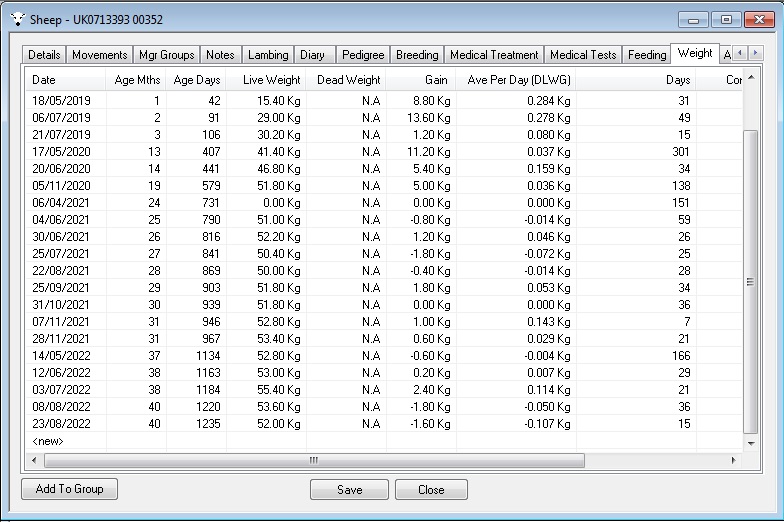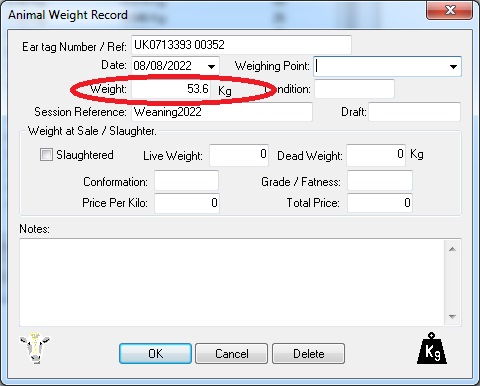Sheep Weighing Introduction
When it comes to sheep performance the animals weight and weight measurements are our main source of performance data. Weight records are recorded on an individual ear tag number and date. Each animal may therefore have multple weight records ranging from 2 or 3 for a lamb, to 20 - 25 for a 5 year ewe.
A weight record has a DATE, Tag Number and Weight in Kilos
A basic weight record is no more than the date the animal was weighed, the weight and the tag number of the animal. Weight gain, age of animal etc all all calculated from other data.. The weights for an individual animal are visible on the animals record, weights tab.

The Weight Record
You may manualy enter the weight of an animal or edit an existing record, double click the <new> entry in the list to add a new record, but NOTE normally we download them from a weigh head!

You may edit or delete an existing record. a weighing point is not required. the Draft field is normally updated when importing weights and records the direction the animal was drafted out.
Condition (BCS)
The Condition is for entering a BCS (Body Condition Score) value. Again these may be downloaded from the weigh head when downloading weight. You may also enter a condition score with a 0 weight value.
Session Reference
A session reference is used to group weight records that were recorded in the same session or on the same day. This session reference is taken from the tru-test file name when downloaded froma tru-test weighing head. You should therefore take great care when naming a file and we would recommend including the year either at the begining or end of the file name, for example 8WeekWeights2022
Slaughter Weights
The weight record is also used for slaughter information, normally a live weight is not recorded, just the dead weight, confirmation or grade. Again these are normally imported from a slaughter house report.
Birth Weights, Weaning Weights and weighing point weights
The system recognises a birth weight as any weight recorded within 4 days of the animals date of birth. If multiple records exist then the first record is taken.
Weaning weights are taken as any weight correspoding with the weaning date of the animal. You may wean lambs in mass from the breeding menu.
Weighing Point Weights are defined by weighing points, an aging in days depent on the animals date of birth, for example 8 Week Weights 56 days. These weighing points have a start and finish day defining a window when weight are acceptable. The actual weight being calculated from the nearest recorded date.
Weighing your animals is one of the most important things to do. Analysing and acting on the weight and weight gain (or not) is more important!
The weight of the lamb is a key performance indicator. It is also a good guide to how good our management is. Lamb growth is down to its mum in the early days of life and our management for the rest of it. Poor growth rates are up to us to sort out so analysing the weights and asking yourself 'Is this me' is important. Which is why downloading your weights from your weigh head at the end of the season is pritty useless. You need to look at them as you record them, thinking as you record them and take action immediately if you think your have a problem.
Growth Rates and Weighing Period
In the early day a lamb can grow at quite remarkable rates if it has the milk. Growth rate in excess of 600 grams a day (0.6Kg) are possible for single ram lambs, Twins 400 grams (0.4 KG) for twins with a good mother. They can maintain this growth rate on almost a straight line for 2 - 3 Months or until they reach the target slaughter weight of 42.5 Kg. We are seeing Lambs go to slaughter at 42.5 Kg in under 64 days.
So a lamb can do over 3 Kg in a week, but this is a problem when it comes to weighing. The gut fill of the animal can asl be 2 - 4 kilo. so Empty compared to Full the animal may show no gain or exceptional gain.
When weighing live animals we may always be out by 2 - 4 kilo.
Weight the same animal evry day, we would be unlikely to see much growth in a week as gut fill could 'hide' the weight gain. Weighing weekly it may be clearer but still confusing. weight 3 - 4 weeks apart we should always see weight gain if there is more than 2 - 3 Kg
So By Regular Weighing, We Mean 3 - 4 weeks from the 8 week weight
Starting early with a 8 Week Weight to identify ewe performance, then regular 3 - 4 week weights to monitor growth rates and any checks due to paracites. Weaning get the weight at the date of weaning. When selecting finished animals you may weigh weekly. Ideally each animal will get 3 - 4 weight records, but may only have ONE if its 42.5 Kg at 62 days.
Birth Weights
If time allows during lambing then record birth weights, but if you are pushed for time do not worry unless you think you have a problem with lambing ease or light lambs. The system has a default birth weight for animals not weighed at birth, lambs do not weigh 0 kg at birth, by default this is 4kg but you can change this in the system settings.
Weight Analysis
There are many weight reports and analysis tools. Including usefull graph's and statistics by sire, dam, breed etc
When comparing animals we prefer weighing points with the actual weight converted to the weighing point weight based on growth rate. Weighing points allow us to compare animals of different ages.